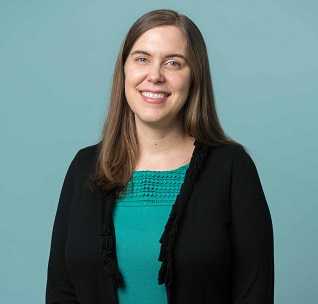IMT is laser-focused on unleashing the potential of energy-efficient buildings to improve bottom lines and property value, drive economic growth, and reduce harmful pollution to create healthier, resilient cities. Collaborating with building owners, tenants, governments, and other city and corporate stakeholders, as well as NGOs and strategic partners, IMT’s expert staff strive to catalyze collective and permanent market change. So, who is IMT? Get to know our subject matter experts in this blog series.
 Megan Houston, IMT’s Program Manager for Multifamily Finance, understands the ins and outs of buildings from design to contracts. She applies her in-depth knowledge at IMT to support healthy communities in efficient buildings that are both cost-effective and climate resilient.
Megan Houston, IMT’s Program Manager for Multifamily Finance, understands the ins and outs of buildings from design to contracts. She applies her in-depth knowledge at IMT to support healthy communities in efficient buildings that are both cost-effective and climate resilient.
When did you gain an interest in building efficiency?
I started my career in interior design and really enjoyed creating tangible spaces that affect people’s lives—particularly office and commercial spaces.
Then, the 2007 Intergovernmental Panel on Climate Change (IPCC) report came out. Reading it, I realized that the types of buildings I was working on had a significant impact on climate change and that there was huge opportunity for mitigation. This affected me enough that I wanted to go back to school to study sustainability. I realized how much of an impact policy and legislation can have on creating healthy communities, so I went to law school so that I could help facilitate conversations. I also thought that people who know about buildings should be writing the relevant policies.
In law school, I studied real estate transaction law and community development law. When I came across a position at IMT working on energy efficiency finance in multifamily buildings, I knew it was just what I wanted to be doing.
How do you apply your previous experience to your current projects?
At IMT, I apply my law degree plus my design background to energy efficiency because both transactions and design are essential to creating good buildings.
A lot of my work impacts affordable housing communities, such as promoting utility savings programs for low- and moderate-income residents or consulting with cities as they conduct energy efficiency outreach. Having the legal perspective, particularly with my focus on community development, is extremely useful when creating successful programs for that sector.
While in law school, I worked at a nonprofit focused on affordable housing development finance, so I understand how deals are put together for those projects and why it’s so complicated—there is no simple answer for energy efficiency, particularly in buildings that need updates the most.
Similarly, my design background means I understand how buildings are made and designed and how complicated building components work together, which is extremely useful when trying to convince people to update them.
What does market transformation mean to you, and how does your current work at IMT move us toward that goal?
I think the end goal of market transformation is when energy efficiency is simple and easy enough that it just becomes “the way”—when building owners and customers alike do not think about any other option except for efficient buildings.
Until we remove all the market barriers, it can often be more tedious to seek out efficiency rather than accept business as usual. My work aims to allow efficiency to be properly valued and to create programs that provide assistance and ease so that efficiency becomes the way everyone does business.
For example, can we utilize the regular cycle of residents moving in and out of multifamily buildings? If standard business practice included simple energy efficiency upgrades in the turnover protocol before new residents move into a unit, apartments could recognize 10 percent energy cost-savings in each unit without any real inconvenience to the building owner or manager. Currently, I’m leading a demonstration project for this concept with an apartment complex in Washington, D.C. that we hope to scale throughout the city with our partner, the DC Sustainable Energy Utility.
What is the biggest challenge you face in your work?
Energy efficiency is one priority among many when you’re talking about people. First, they need to be safe, healthy, and fed. IMT works to show how efficiency can support these basic needs by helping buildings become healthier environments that require smaller amounts of income for utility bills while also freeing up resources for building owners to maintain their buildings.
What most excites you about working with cities and local communities?
Even though I’ve recently moved to the suburbs, I love living and working in cities and being surrounded by people from all different backgrounds and areas of expertise. Working with cities to use their resources in an efficient way feels worthwhile, and I know I’m contributing something of value toward society while also just being a good neighbor.
I also care about climate change and the vulnerable populations that will be impacted by the effects of it—the people who are most at risk are oftentimes the ones who I can help the most through simple energy programs. An efficient building can save money on utility bills, and it can also withstand climate risks better than an inefficient building. That’s why we have to improve our building stock now.
To meet more of IMT’s subject matter experts, visit our staff page.